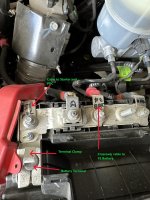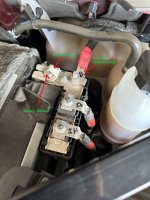2019 Ram 2500 Bighorn Cummins
I need some guidance here please. Everything was normal when I parked my truck last Friday afternoon. The next day, Saturday afternoon, the truck would not start. The truck engine will not turn over. The batteries are reading 12.4 volts. I verified adequate voltage at the starter motor. I assumed the starter was bad & installed a new one. It still won't turn over. I confirmed manually that the engine & all pulleys rotate freely. During the start cycle it has a audible click from the starter & you can see a very slight momentary movement of the engine but, it will not turn over to start.
Am I missing something that would prevent the starter from running & cranking the engine?
I will add that a few weeks ago I checked the batteries before leaving on a trip & all appeared normal. After the truck wouldn't start I obviously checked the batteries again & discovered the drivers side negative terminal had developed excessive corrosion (which has been cleaned).
Any suggestions are appreciated!
I need some guidance here please. Everything was normal when I parked my truck last Friday afternoon. The next day, Saturday afternoon, the truck would not start. The truck engine will not turn over. The batteries are reading 12.4 volts. I verified adequate voltage at the starter motor. I assumed the starter was bad & installed a new one. It still won't turn over. I confirmed manually that the engine & all pulleys rotate freely. During the start cycle it has a audible click from the starter & you can see a very slight momentary movement of the engine but, it will not turn over to start.
Am I missing something that would prevent the starter from running & cranking the engine?
I will add that a few weeks ago I checked the batteries before leaving on a trip & all appeared normal. After the truck wouldn't start I obviously checked the batteries again & discovered the drivers side negative terminal had developed excessive corrosion (which has been cleaned).
Any suggestions are appreciated!


